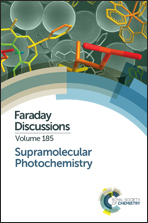Abstract
The effects of an artificial cyclohexyl base pair on the quantum yields of fluorescence and dynamics of charge separation and charge recombination have been investigated for several synthetic DNA hairpins. The hairpins possess stilbenedicarboxamide, perylenediimide, or naphthalenediimide linkers and base-paired stems. In the absence of the artificial base pair hole injection into both adenine and guanine purine bases is exergonic and irreversible, except in the case of stilbene with adenine for which it is slightly endergonic and reversible. Insertion of the artificial base pair renders hole injection endergonic or isoergonic except in the case of the powerful naphthalene acceptor for which it remains exergonic. Both hole injection and charge recombination are slower for the naphthalene acceptor in the presence of the artificial base pair than in its absence. The effect of an artificial base pair on charge separation and charge recombination in hairpins possessing stilbene and naphthalene acceptor linkers and a stilbenediether donor capping group has also been investigated. In the case of the stilbene acceptor–stilbene donor capped hairpins photoinduced charge separation across six base pairs is efficient in the absence of the artificial base pair but does not occur in its presence. In the case of the naphthalene acceptor–stilbene donor capped hairpins the artificial base pair slows but does not stop charge separation and charge recombination, leading to the formation of long-lived charge separated states.
- This article is part of the themed collection: Supramolecular Photochemistry

 Please wait while we load your content...
Please wait while we load your content...